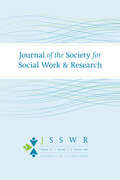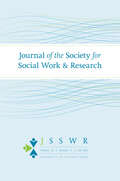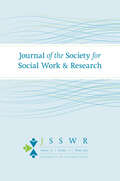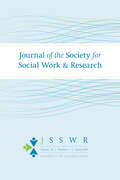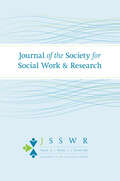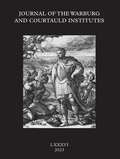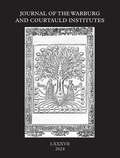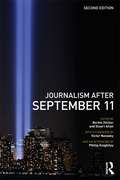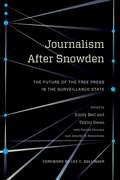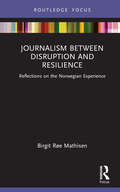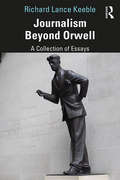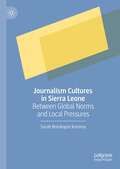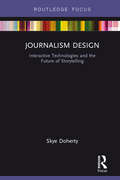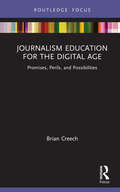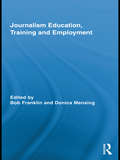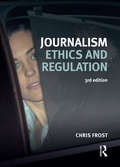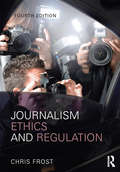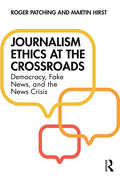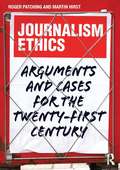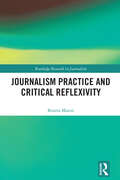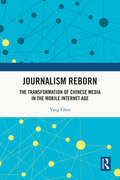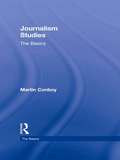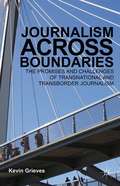- Table View
- List View
Journal of the Society for Social Work and Research, volume 15 number 2 (Summer 2024)
by Journal of the Society for Social Work and ResearchThis is volume 15 issue 2 of Journal of the Society for Social Work and Research. The Journal of the Society for Social Work and Research (JSSWR) is a peer-reviewed publication dedicated to presenting innovative, rigorous original research on social problems, intervention programs, and policies. By creating a venue for the timely dissemination of empirical findings and advances in research methods, JSSWR seeks to strengthen the rigor of social work research and advance the knowledge in social work and allied professions and disciplines. Special emphasis is placed on publishing findings on the effectiveness of social and health services, including public policies and practices. JSSWR publishes an array of perspectives, research approaches, and types of analyses that advance knowledge useful for designing social programs, developing innovative public policies, and improving social work practice.
Journal of the Society for Social Work and Research, volume 15 number 3 (Fall 2024)
by Journal of the Society for Social Work and ResearchThis is volume 15 issue 3 of Journal of the Society for Social Work and Research. The Journal of the Society for Social Work and Research (JSSWR) is a peer-reviewed publication dedicated to presenting innovative, rigorous original research on social problems, intervention programs, and policies. By creating a venue for the timely dissemination of empirical findings and advances in research methods, JSSWR seeks to strengthen the rigor of social work research and advance the knowledge in social work and allied professions and disciplines. Special emphasis is placed on publishing findings on the effectiveness of social and health services, including public policies and practices. JSSWR publishes an array of perspectives, research approaches, and types of analyses that advance knowledge useful for designing social programs, developing innovative public policies, and improving social work practice.
Journal of the Society for Social Work and Research, volume 15 number 4 (Winter 2024)
by Journal of the Society for Social Work and ResearchThis is volume 15 issue 4 of Journal of the Society for Social Work and Research. The Journal of the Society for Social Work and Research (JSSWR) is a peer-reviewed publication dedicated to presenting innovative, rigorous original research on social problems, intervention programs, and policies. By creating a venue for the timely dissemination of empirical findings and advances in research methods, JSSWR seeks to strengthen the rigor of social work research and advance the knowledge in social work and allied professions and disciplines. Special emphasis is placed on publishing findings on the effectiveness of social and health services, including public policies and practices. JSSWR publishes an array of perspectives, research approaches, and types of analyses that advance knowledge useful for designing social programs, developing innovative public policies, and improving social work practice.
Journal of the Society for Social Work and Research, volume 16 number 1 (Spring 2025)
by Journal of the Society for Social Work and ResearchThis is volume 16 issue 1 of Journal of the Society for Social Work and Research. The Journal of the Society for Social Work and Research (JSSWR) is a peer-reviewed publication dedicated to presenting innovative, rigorous original research on social problems, intervention programs, and policies. By creating a venue for the timely dissemination of empirical findings and advances in research methods, JSSWR seeks to strengthen the rigor of social work research and advance the knowledge in social work and allied professions and disciplines. Special emphasis is placed on publishing findings on the effectiveness of social and health services, including public policies and practices. JSSWR publishes an array of perspectives, research approaches, and types of analyses that advance knowledge useful for designing social programs, developing innovative public policies, and improving social work practice.
Journal of the Society for Social Work and Research, volume 16 number 2 (Summer 2025)
by Journal of the Society for Social Work and ResearchThis is volume 16 issue 2 of Journal of the Society for Social Work and Research. The Journal of the Society for Social Work and Research (JSSWR) is a peer-reviewed publication dedicated to presenting innovative, rigorous original research on social problems, intervention programs, and policies. By creating a venue for the timely dissemination of empirical findings and advances in research methods, JSSWR seeks to strengthen the rigor of social work research and advance the knowledge in social work and allied professions and disciplines. Special emphasis is placed on publishing findings on the effectiveness of social and health services, including public policies and practices. JSSWR publishes an array of perspectives, research approaches, and types of analyses that advance knowledge useful for designing social programs, developing innovative public policies, and improving social work practice.
Journal of the Warburg and Courtauld Institutes, volume 86 number 1 (2023)
by Journal of the Warburg and Courtauld InstitutesThis is volume 86 issue 1 of Journal of the Warburg and Courtauld Institutes. The Journal of the Warburg and Courtauld Institutes is an interdisciplinary forum, uniting scholars specialising in cultural history including the history of art, and intellectual history including the history of ideas. It publishes articles based on new research, normally from primary sources. The subject matter encompasses intellectual themes and traditions, the arts in their various forms, religion, philosophy, science, literature and magic, as well as political and social life, from antiquity to the dawn of the contemporary era. Just as the work of the Warburg and Courtauld Institutes is known for crossing cultural borders, the JWCI provides a home for research into the many connections between European cultures and the wider world—especially the Near East, Asia and the Americas.
Journal of the Warburg and Courtauld Institutes, volume 87 number 1 (2024)
by Journal of the Warburg and Courtauld InstitutesThis is volume 87 issue 1 of Journal of the Warburg and Courtauld Institutes. The Journal of the Warburg and Courtauld Institutes is an interdisciplinary forum, uniting scholars specialising in cultural history including the history of art, and intellectual history including the history of ideas. It publishes articles based on new research, normally from primary sources. The subject matter encompasses intellectual themes and traditions, the arts in their various forms, religion, philosophy, science, literature and magic, as well as political and social life, from antiquity to the dawn of the contemporary era. Just as the work of the Warburg and Courtauld Institutes is known for crossing cultural borders, the JWCI provides a home for research into the many connections between European cultures and the wider world—especially the Near East, Asia and the Americas.
Journalism After September 11 (Communication and Society)
by Stuart Allan Barbie ZelizerPraise for the first edition: This collection of essays comes mainly from academics but nobody should bridle at theorists lecturing practitioners. They properly challenge the way September 11th was reported - in a way that's both an endorsement of the role of the media and a wake-up call on its failures . . . anyone interested in our trade should read it.' - Roger Mosey, Ariel'A thoughtful and engaging examination of the effects of 9/11 on the field of journalism. Its unique aim is to discuss the impact of the attack as a personal trauma and its current and future effects on journalism and the reporting of the news. . . highly recommended.' - Library Journal Journalism After September 11 examines how the traumatic attacks of that day continue to transform the nature of journalism, particularly in the United States and Britain. Familiar notions of what it means to be a journalist, how best to practice journalism, and what the public can reasonably expect of journalists in the name of democracy, were shaken to their foundations. Ten years on, however, new questions arise regarding the lasting implications of that tragic day and its aftermath. Bringing together an internationally respected collection of scholars and media commentators, Journalism After September 11 addresses topics such as: journalism and public life at a time of crisis; broadsheet and tabloid newspaper coverage of the attacks; the role of sources in shaping the news; reporting by global news media such as CNN; Western representations of Islam; current affairs broadcasting; news photography and trauma; the emotional well-being of reporters; online journalism; as well as a host of pertinent issues around news, democracy and citizenship. This second edition includes four new chapters – examining Arabic newspaper reporting of the attacks, the perceptions of television audiences, national magazine coverage of the ensuing crisis, and the media politics of ‘othering’ – as well as revised chapters from the first edition and an updated Introduction by the co-editors. A foreword is provided by Victor Navasky and an afterword by Phillip Knightley.
Journalism After Snowden: The Future of the Free Press in the Surveillance State (Columbia Journalism Review Books)
by Taylor Owen Emily BellEdward Snowden's release of classified NSA documents exposed the widespread government practice of mass surveillance in a democratic society. The publication of these documents, facilitated by three journalists, as well as efforts to criminalize the act of being a whistleblower or source, signaled a new era in the coverage of national security reporting. The contributors to Journalism After Snowden analyze the implications of the Snowden affair for journalism and the future role of the profession as a watchdog for the public good. Integrating discussions of media, law, surveillance, technology, and national security, the book offers a timely and much-needed assessment of the promises and perils for journalism in the digital age.Journalism After Snowden is essential reading for citizens, journalists, and academics in search of perspective on the need for and threats to investigative journalism in an age of heightened surveillance. The book features contributions from key players involved in the reporting of leaks of classified information by Edward Snowden, including Alan Rusbridger, former editor-in-chief of The Guardian; ex-New York Times executive editor Jill Abramson; legal scholar and journalist Glenn Greenwald; and Snowden himself. Other contributors include dean of Columbia Graduate School of Journalism Steve Coll, Internet and society scholar Clay Shirky, legal scholar Cass Sunstein, and journalist Julia Angwin. Topics discussed include protecting sources, digital security practices, the legal rights of journalists, access to classified data, interpreting journalistic privilege in the digital age, and understanding the impact of the Internet and telecommunications policy on journalism. The anthology's interdisciplinary nature provides a comprehensive overview and understanding of how society can protect the press and ensure the free flow of information.
Journalism Between Disruption and Resilience: Reflections on the Norwegian Experience (Disruptions)
by Birgit Røe MathisenFollowing recent developments in digital technologies, financial crises, and changes in audience preferences, this book addresses the critical challenges and disruptions facing the profession of journalism: an arguably precarious industry suffering from employment insecurity, individualization, and loss of autonomy. Drawing on research from the Norwegian and Nordic media landscape, Journalism Between Disruption and Resilience elaborates on how boundary struggles between journalism and other forms of content, such as marketing and public relations, have become blurred, while social distinctions within the profession are deepened and exacerbated by downsizing and cutbacks in newsrooms and their journalistic staffs. The impact of these developments on the institutional and democratic role of journalism in society is discussed alongside the tensions between professional autonomy and precarious work. Expanding upon several earlier research studies, grounded in the sociology of professions and freelance work, this book provides a new theoretical framework from which to addressjournalistic precarity and the role of journalism in society. This is an insightful study for advanced students and researchers in the areas of professional journalism, journalism education, and media industries including marketing and public relations.
Journalism Between the State and the Market (Disruptions)
by Helle SjøvaagUsing the Nordic media model as an empirical backdrop, Journalism Between the State and the Market defines and analyzes journalism’s fundamental problem: its shifting location between the state and the market. This book examines how this distance is decreasing as journalism steps closer to both the market (algorithmically monetizing audiences) and the state (lobbying governments for subsidies and attacking public service broadcasting). The book analyzes journalism’s negotiated position between the market and the state in the age of disruptions, offering a theoretical foundation that seeks to account for the structural conditions of journalism in the digital age. For scholars, graduates and students in journalism, news sociology and media and communication studies, Journalism Between the State and the Market provides a theoretical perspective that can be used as a valuable tool when studying and observing the current developments in journalism.
Journalism Beyond Orwell
by Richard Lance KeebleJournalism Beyond Orwell adapts and updates pioneering work by Richard Lance Keeble to explore George Orwell’s legacy as a journalist in original, critical – and often controversial – ways. Though best known as the author of Animal Farm and Nineteen Eighty-Four, Orwell was, throughout his career, a journalist. The essays in this collection explore Orwell’s important legacy: as a practising activist journalist critical of the dominant media; as a polemicist, essayist and novelist constantly concerned with issues relating to war and peace; as a literary journalist determined to make ‘political writing an art’; and as a writer who warned of the growing powers of the secret state. Through this highly individualistic essay collection that connects Orwellian themes to modern journalism, Richard Lance Keeble explores key topics, including: Orwell the ‘proto-blogger’ How Orwell put his political economy critique of the corporate press into practice Information warfare in an age of hyper-militarism The manufacture of the myth of heroic warfare in the reporting of the Afghan conflict The debates over the theory and practice of peace journalism The ethical challenges for journalists reporting on conflict The crucial role of the alternative media The pleasures and pitfalls of the celebrity profile This collection will be of particular interest to students and researchers in journalism studies, English literature, media, intelligence studies and international relations.
Journalism Cultures in Sierra Leone: Between Global Norms and Local Pressures
by Sarah Bomkapre KoromaThis book provides novel insights into the perspectives of journalists in Sierra Leone and on their work by examining their perceived journalistic values and the influences that shape them. It treats journalism as an occupational identity and as a community that works on the foundation of the sub-Saharan African philosophies that exalts communal values in every sphere of life. When journalists speak about their social function in society and values, they are sharing both their individual knowledge and experiences on their work. Therefore, journalistic values are never isolated ideologies, but exist within the contexts in which they practice. In this book, Sarah Bomkapre Koroma examines the perceptions of journalists on the societal influences that impact their work, ranging from individual, procedural, organizational, political, economic, and many more. Questions explored include:What journalism cultures exist in Sierra Leone?What effects do societal factors have on these journalistic cultures?How do journalists in Sierra Leone describe their roles?What epistemological underpinnings do they consider during practice?What ethical considerations do the journalists share?
Journalism Design: Interactive Technologies and the Future of Storytelling (Disruptions)
by Skye DohertyJournalism Design is about the future of journalism. As technologies increasingly, and continually, reshape the way we interact with information, with each other and with our environment, journalists need new ways to tell stories. Journalists often see technology as something that improves what they are doing or that makes it more convenient. However, the growing might of technology companies has put journalism and news organisations in a difficult position: readers and revenues have moved, and platforms exert increasing control over story design. Skye Doherty argues that, rather than adapting journalism to new technologies, journalists should be creating the technologies themselves and those technologies should be designed for core values such as the public interest. Drawing from theories and practices of interaction design, this book demonstrates how journalists can use their expertise to imagine new ways of doing journalism. The design and development of the NewsCube, a three-dimensional storytelling tool, is detailed, as well as how interaction design can be used to imagine new forms of journalism. The book concludes by calling for closer ties between researchers and working journalists and suggests that journalism has a hybrid future – in newsrooms, communities, design studios and tech companies.
Journalism Education for the Digital Age: Promises, Perils, and Possibilities (Disruptions)
by Brian CreechThis book examines pressing debates concerning how and why journalism education should respond to digital changes in and around the industry, and questions market oriented ideology and civic responsibility in the field. Surveying a broad field of discourse and research into journalism education, Creech shows how public ideals, market logics and industry concerns have come to animate discussions about digital journalism education and journalism’s future, and how academic structures and cultures are positioned as a key obstacle to attaining that future. The book examines labor conditions, critiques of journalism education as an institution, and curricular change, with reference to how conversations around race, fake news, and digital infrastructures impact the field. Creech argues for a critical pedagogy of journalism education, one that pushes beyond jobs training and instead is centred around a commitment to public and civic value via a liberal arts tradition made practicable for the digital age. This insightful book is vital reading for journalism educators and scholars, as well as journalists and news executives, education scholars, and program officers and decision-makers at journalism-adjacent foundations and think tanks.
Journalism Education, Training and Employment (Routledge Research in Journalism)
by Bob FranklinDuring this period of rapid and significant change in journalistic practices, journalism educators are re-examining their own profession and contributing to the invention of new models and practices. This edited volume of studies by respected international scholars describes the diverse issues journalism educators are grappling with and the changes they are making in purpose and practice. The book is organized into three sections -- education, training and employment – that explore common themes: How the assumptions embedded in journalism education are being examined and revised in the light of transformative changes in communication; How the definitions of journalism and journalists are broadening in scope and what this means for educators; How newsrooms and training programs around the world are being re-examined and made more effective. An introductory essay and section summaries provide context for the thirteen chapters that constitute the collection. The section on journalism education explores fundamental ways educators are seeking to make their institutions and practices stronger and more responsive. The section on training includes case studies of journalism training programs in sub-Saharan Africa, Turkey, Sweden and the U.S. The final section examines the job prospects and employment market for journalism students with data from the U.S., U.K, Australia, and Sweden. The scope of issues considered in the book makes it a valuable resource for journalism scholars from around the world, as well as doctoral students, journalism and communication administrators in universities, organizations that fund journalism training programs, and practitioners interested in understanding employment and education trends.
Journalism Ethics and Regulation
by Chris FrostTechnology, and the democratising of news gathering, continue to change traditional journalistic practice making the path through ethical and regulatory frameworks tough to negotiate. As high-profile celebrity cases such as Max Mosley's vividly illustrate, conflicts between the law, ethics and the public's right and desire to be informed are not easily resolved. This comprehensive volume addresses the ethical considerations, dilemmas and challenges the practising journalist faces, each minute, every day. Providing context and practical advice, it explores an area of crucial importance for the 21st century, thoroughly equipping the reader with the information and tools to negotiate this challenging area knowledgeably, practically and responsibly. This book has been written for students and trainee journalists, working journalists and editors, and indeed for any student of the media.
Journalism Ethics and Regulation
by Chris FrostThe new edition of Journalism Ethics and Regulation presents an accessible, comprehensive and in-depth guide to this vital and fast moving area of journalistic practice and academic study. The fourth edition presents expanded and updated chapters on: Privacy, including the pitfalls of Facebook privacy policies and access to social media as a source Gathering the news, including dimensions of accessing material online, the use of crowd sourcing, email interviews, and the issues surrounding phone hacking, blagging and computer hacking New regulation systems including comparison of statutory, state and government regulation, pre-publication regulation, online regulation, and the impact of the Leveson Enquiry on regulation Exploration of who regulates and the issues regarding moderation of user content Journalism ethics and regulation abroad, including European constitutional legalisation, ethics and regulation in the former Soviet states, and regulation based on Islamic law. The book also features brand new chapters examining ethical issues on the internet and journalism ethics, and print regulation in the 21st century. Journalism Ethics and Regulation continues to mix an engaging style with an authoritative approach, making it a prefect resource for both students and scholars of the media and working journalists.
Journalism Ethics at the Crossroads: Democracy, Fake News, and the News Crisis
by Martin Hirst Roger PatchingThis book provides journalism students with an easy-to-read yet theoretically rich guide to the dialectics, contradictions, problems, and promises encapsulated in the term ‘journalism ethics’. Offering an overview of a series of crises that have shaken global journalism to its foundations in the last decade, including the coronavirus pandemic, the Black Lives Matter movement, and the 2020 US presidential election, the book explores the structural and ethical problems that shape the journalism industry today. The authors discuss the three principle existential crises that continue to plague the news industry: a failing business model, technological disruption, and growing public mistrust of journalism. Other topics covered include social media ethics, privacy concerns, chequebook journalism, as well as a new analysis of journalism theory that critiques the well-worn tropes of objectivity, the Fourth Estate, freedom of the press, and the marketplace of ideas to develop a sophisticated materialist reimagining of journalism ethics. This is a key text for students of journalism, mass communication, and media ethics, as well as for academics, researchers, and communications professionals interested in contemporary journalism ethics.
Journalism Ethics: Arguments and cases for the twenty-first century
by Martin Hirst Roger PatchingJournalism Ethics: Arguments and Cases for the 21st Century explores the major ethical dilemmas facing journalists in the digital age. Engaging with both the theory and practice of journalism ethics, this text explains the key ethical concepts and dilemmas in journalism and provides an international range of examples and case studies, considering traditional and social media from a global perspective. Journalism Ethics offers an introductory philosophical underpinning to ethics that traces the history of the freedom of expression from the time of Greek philosophers like Aristotle, through the French and American revolutions, to modern day. Throughout the book Patching and Hirst examine ethically-challenging issues such as deception, trial by media, dealing with sources and privacy intrusion. They also explore continuing ethical fault lines around accuracy, bias, fairness and objectivity, chequebook journalism, the problems of the foreign correspondent, the conflicts between ethics and the law and between journalists and public relations consultants. Concluding with a step-by-step guide to ethical thinking on the job, this textbook is an invaluable resource for students of journalism, media and communication.
Journalism Practice and Critical Reflexivity (Routledge Research in Journalism)
by Bonita MasonJournalism Practice and Critical Reflexivity is a theoretical- and practice-based response to the crisis of mission and credibility in journalism studies that is heightened by online and social media. It describes, analyses and offers new approaches and models for critically reflexive journalism research, practice and education. With specific theoretical and conceptual approaches employed, such as Pierre Bourdieu’s reflexive sociology along with the analytical, practice-based, reflective and narrative techniques of Donald Schön and autoethnography, this book provides possible responses to these crises of purpose and legitimacy, and to transformation, in Western corporate journalism. With journalists working in mainstream media under increasing pressure, the book considers the possibility of either slowing journalism down or having elements of a more reflexive journalism practice set alongside other routine practices. It proposes reciprocity as a core value to guide much investigative and news journalism.Scholars and practitioners of journalism, researchers and post-graduate students interested in journalism, critical reflexivity and reflective practice in relevant disciplines can apply the concepts and techniques of critical reflexivity in their own research or teaching. Journalists, criminologists and others concerned with Indigenous deaths in custody, prisons, the institutional duty of care, social and/or legal justice and effective government administration will also find the study rewarding.
Journalism Reborn: The Transformation of Chinese Media in the Mobile Internet Age
by Yang ChenThis book examines the strategies Chinese news media have implemented to address the challenges posed by the mobile internet to Chinese journalistic practices and businesses.Using a variety of qualitative and quantitative research methods, the book analyzes the transformation of media convergence in China based on the characteristics of the mobile internet. From three key perspectives—media organization, content, and users—the book discusses the difficulties Chinese journalism faces due to technological advances and analyzes the evolving strategies of Chinese media and their implications. In doing so, the book provides a vivid picture of the transformation of Chinese journalism in the mobile internet era and initiates a theoretical dialogue with global journalism studies.The title will appeal to scholars and students of journalism, news media, and communication, especially those interested in the case of China.
Journalism Studies: A Critical Introduction
by Philip Hammond Andrew CalcuttAs the world of politics and public affairs has gradually changed beyond recognition over the past two decades, journalism too has been transformed... yet the study of news and journalism often seems stuck with ideas and debates which have lost much of their critical purchase. Journalism is at a crossroads: it needs to reaffirm core values and rediscover key activities, almost certainly in new forms, or it risks losing its distinctive character as well as its commercial basis. Journalism Studies is a polemical textbook that rethinks the field of journalism studies for the contemporary era. Organised around three central themes – ownership, objectivity and the public – Journalism Studies addresses the contexts in which journalism is produced, practised and disseminated. It outlines key issues and debates, reviewing established lines of critique in relation to the state of contemporary journalism, then offering alternative ways of approaching these issues, seeking to reconceptualise them in order to suggest an agenda for change and development in both journalism studies and journalism itself. Journalism Studies is a concise and accessible introduction to contemporary journalism studies, and will be highly useful to undergraduate and postgraduate students on a range of Journalism, Media and Communications courses.
Journalism Studies: The Basics (The Basics)
by Martin ConboyJournalism Studies: The Basics provides an introductory overview of the emerging field of Journalism Studies, discussing key issues and contemporary debates. Drawing on Conboy’s extensive experience in the field, the changing nature of journalism and its future directions are addressed, through chapters covering: the history and development of Journalism Studies how journalists are created through training and education changing research methods and processes in journalism the impact of the ‘end product’ in wider society global perspectives on journalism technology and the future of the discipline. Situated within a fast growing and dynamic field of study, this engaging introduction will be valuable reading for students of journalism, media and communication, along with those seeking to develop a broader understanding of contemporary journalism.
Journalism across Boundaries
by Kevin GrievesJournalistic activity crosses national borders in creative and sometimes unexpected ways. Drawing on many interviews and newsroom observation, this book addresses an overlooked but important aspect of international journalism by examining how journalists carry out their daily work at the transnational and regional transborder level.
